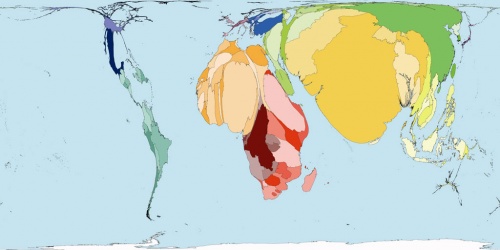Talk:Lecture - Fetal Development
Stillbirth and Perinatal Death
The distorted world map above shows the relative distribution of early neonatal death by country. Note the over-representation of Africa and Asia compared with Europe, USA and Australia. [1]
New South Wales (2002)
Perinatal deaths (period up to 7 days after birth)
- 613 perinatal deaths were reported
- Unexplained antepartum deaths: 26.3% of perinatal deaths (or 39.2% of stillbirths)
- Spontaneous preterm labour: 20.6% (less than 37 weeks gestation)
- Congenital abnormality: 16.8%
- Antepartum haemorrhage: 8.5%
- Specific perinatal conditions: 7.3%, of which twin-twin transfusion accounted for 2.3% of deaths
- Hypertension (high blood pressure): 5.5%
- Perinatal infection: 4.4%
- Maternal disease: 4.4%
- Hypoxic peripartum death: 3.8%
Neonatal deaths (four weeks/month after birth)
- extreme prematurity was most common cause (39.6%)
- congenital abnormality (19.3%)
- neurological disease (13.4%)
- cardio-respiratory conditions (11.9%)
- infection (8.4%)
Data from Report of the New South Wales Chief Health Officer, 2004 (accessed 19Oct05)
Transverse bone growth and cortical bone mass in the human prenatal period
Biol Neonate. 1992;62(1):23-31.
Rodríguez JI, Palacios J, Rodríguez S. Source Department of Pathology, La Paz Hospital, Madrid, Spain.
Abstract
The prenatal development of the normal diaphysis of the human long bone was studied through postmortem radiographs in 60 stillborns and 86 newborns of 20-41 weeks gestational age. Quantitative parameters were determined for the tibia, femur, and humerus. In all three long bones, significant positive correlations were found between the diaphyseal diameter, medullary diameter, cortical thickness, and cortical area, and the gestational age, body weight, body height, and bone length. No significant differences in any studied parameters were observed between males and females. In the tibia, the diaphyseal diameter grew more than in the femur and humerus. In these two latter bones, the medullary diameter growth rate was greater than the diaphyseal diameter growth rate, and thus the Barnett-Nordin index and percentage of cortical area showed mild but significant negative correlations with gestational age, body weight, body height, and bone length.
- The velocity of medullary diameter growth was similar (0.05 mm/week) in all three long bones
- velocity of diaphyseal diameter growth was greater in the tibia (0.161 mm/week) than in the femur (0.142 mm/week) or humerus (0.129 mm/week).
- The diaphyseal growth rate decreased in the second half of the period studied in all three bones. This decrease was more striking in the humerus. Observed differences in diaphyseal growth among the long bones studied may be genetically determined in relation to its different postnatal functions.
PMID 1391272

